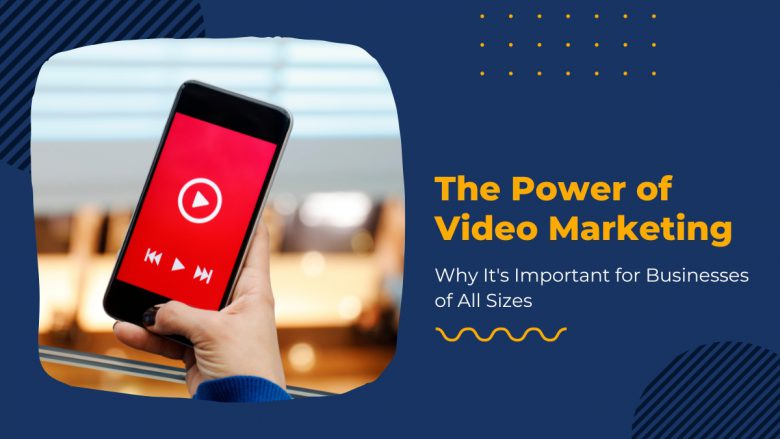
Video marketing is becoming increasingly popular among businesses of all sizes, as more and more realize the immense power it can have on their success. From small startup companies to Fortune 500 corporations, video marketing is proving to be an effective way to reach a wider audience, increase engagement, and ultimately boost sales. In this article, we will explore why video marketing is so important for businesses of all sizes and how they can leverage its powerful capabilities.
I. Planning Your Video Marketing Strategy
Define your target audience:
Planning a successful video marketing strategy starts with understanding who you are creating your videos for. Knowing your target audience is essential in creating content that will engage them and build relationships within the community. Once you have identified who your target audience is, you can start to define the key messages and topics that will resonate with them.
When defining your target audience, think of important demographics such as age, gender, location, interests, and job roles. This will help you gain an understanding of what type of content they are likely to watch and which platforms they use to connect with other people and businesses. Additionally, it allows you to know where to place your videos for maximum engagement. Knowing this information helps tailor your message so it resonates more deeply with those watching it.
Set goals for your video content:
Video marketing is becoming an increasingly popular way for businesses to reach a wider audience and increase their brand visibility. Businesses need to plan out their video strategy to achieve the desired results. Setting goals helps make sure that companies are using video content in the right way and that it contributes towards business objectives.
When planning your video marketing strategy, it’s critical to set measurable goals so you can track whether or not you’re succeeding. Consider the type of content you want to produce, how often you plan on releasing videos, and who your target audience is. Additionally, determine what metrics will be used to measure success such as engagement rate, number of views, or website traffic from people clicking on the link shared with the video. Once these things have been decided upon, break them down into smaller goals over some time so progress can be monitored closely.
Choose the right format:
Planning your video marketing strategy can be daunting, but it doesn’t have to be. With the right guidance, you can make sure that the videos you create are reaching the right audience and achieving your desired goals. Deciding which types of videos will best suit your goals and audience is an important part of a successful video marketing strategy.
You need to identify exactly what objectives you want to accomplish with each of your videos so that you can narrow down which type of content will work best for achieving those goals. It’s also important to consider who your target audience is when making this decision so that the format resonates with them. Examples of different types of formats include animated explainer videos, live-action product demonstrations, webinars, interviews, or tutorial-style how-to content.
Create a content calendar:
Creating a content calendar is an essential part of any video marketing strategy. Planning your video content in advance can help you ensure that your videos are released on time and meet the needs of your audience. Scheduling ahead of time, also allows you to spread out the timing of different types of videos throughout each month.
When creating a content calendar, there are many factors to consider. You should think about the topics you want to cover, how often you want to post, and when each video should be released. Additionally, it’s important to keep track of what kind of reaction each video receives from viewers so that you can adjust your strategy accordingly for future videos. Once all these elements have been taken into account, it’s time to start planning which specific topics will make up each month’s content schedule.
II. Creating Engaging Video Content
Keep it short and sweet:
Creating engaging video content is a challenge for many marketers. With attention spans on the decline, it is becoming more and more important to create videos that are short and sweet. Videos under 2 minutes should be the goal when creating content as research shows that users lose interest and engagement after just 120 seconds of viewing time.
Keeping videos short doesn’t mean they need to be dull, however. In fact, shorter videos can increase engagement since viewers can digest information quickly without feeling overwhelmed or bored by long-winded content. To get the most out of your video content, add in some captivating visuals such as graphics or music coupled with an impactful message. Utilizing this technique will help keep viewers engaged for the duration of your two-minute video clip!
Make it visually appealing:
Creating engaging video content is a great way to attract and engage your audience. But to make sure that your videos stand out from the crowd, it’s important to invest in high-quality equipment and editing software.
From cameras, lenses, and microphones to editing software like Adobe Premiere Pro and Final Cut Pro X, having the right tools can help you create professional-looking videos that are both visually appealing and engaging. High-quality cameras can help you capture stunning visuals while high-quality microphones will ensure that your audio is crisp and clear. Similarly, powerful editing software will give you the power to create professional-looking videos with ease.
By investing in the right equipment and software, you’ll be able to create visually appealing video content that captivates viewers – all without breaking the bank!
Tell a story:
Creating engaging video content isn’t always easy. But one way to make your videos more memorable is through storytelling. By using stories, you can capture the attention of your audience and help them connect with your message in a meaningful way.
Stories are powerful tools for engaging viewers, as they evoke emotions and create an immersive experience that resonates with audiences on a deeper level. Whether it’s a narrative or just an anecdote, giving your video content a story arc will help keep viewers interested throughout the viewing process and provide them with something to reflect upon afterward.
When telling stories through video content, you should focus on the characters involved, the context of their actions, and how those actions lead to outcomes that illustrate larger themes or messages within the story being told.
Add value:
Creating engaging video content is essential for building relationships with an audience, driving traffic to your channel, and establishing yourself as an expert in the field. Videos are a great way to show off your knowledge and creativity while providing value to viewers. To add value, be sure to offer useful information or insights in your videos that will benefit the viewers.
Start by creating a strong storyboard with compelling visuals that can captivate the viewer’s attention from start to finish. Include relevant facts, data points, or even quotes from industry experts that can drive home important points and provide useful information for viewers. Additionally, make sure you’re aware of industry trends and current events so you can keep your videos up-to-date and valuable for the viewer.
III. Promoting Your Videos
Share on social media:
Social media has become a major platform for businesses to promote their products and services. Sharing videos on social media is an effective way of reaching out to potential customers and increasing brand awareness. It also serves as an ideal marketing tool for businesses to promote their videos, gain traction, and reach a wider audience.
To get the most out of your social media channels in promoting your videos, you should focus on engaging with viewers by creating content that resonates with the target audience. Additionally, make sure you post interesting visuals and use hashtags relevant to your industry or product offering to increase visibility among other users on various platforms. You can also take advantage of analytics tools available which can help you track the performance of each post in terms of reach and engagement rate so that you can tailor your approach accordingly.
Embed videos on your website:
Creating and promoting videos is an important part of developing your website, as well as a great way to engage with your audience. Embedding videos on your website allows you to easily share content with viewers and can help boost engagement. Additionally, adding video elements to your site can improve the user experience by making it easier for visitors to find the information they are looking for.
When embedding videos onto your website, there are a few things to consider. For example, you should make sure that the video is properly formatted for all devices, including mobile phones and tablets. You may also want to create different versions of the video so that it can be viewed in multiple formats or languages. Lastly, when promoting the video on social media or other platforms, make sure that you provide a link back to your website where viewers can watch it in full.
Optimize for search engines:
Promoting your videos on the web is a great way to get more views and build an audience. But if you want to maximize your reach, it’s important to optimize those videos for search engines. By including the right keywords and descriptions in your videos, you can make them easily discoverable by search engines like Google or Bing.
Including relevant keywords and phrases in titles, descriptions, and tags helps search engine algorithms understand what content is included in each video — which makes them more likely to appear as results when someone searches for related topics. You can also use phrases that describe what the video is about so viewers have a better idea of what they’re clicking into before they watch it. This will not only encourage people to click through to watch your video but it may also give your ranking a boost with the search engine algorithm.
Collaborate with influencers:
Collaborating with influencers is a great way to promote your videos and build credibility for your brand. Partnering with a relevant influencer can help you reach an entirely new audience that may not have been aware of your content before. By working together, you can create engaging and creative videos that will captivate your followers and grow the awareness of your brand.
When selecting an influencer partner, make sure to choose someone who represents the same values as you do and whose target audience aligns with yours. This will ensure that the content resonates with their followers and adds value to their page. Additionally, when creating content together it’s important to focus on creating quality, authentic material that reflects both parties to establish trust and connection between you and the influencer’s fans.
Conclusion
Video marketing is a powerful tool for businesses looking to reach and engage with their audience.
From planning and creation to promotion, there are many steps you can take to ensure your video marketing efforts are successful.
By keeping your target audience in mind, setting clear goals, and promoting your videos effectively, you can boost your brand and drive engagement through video content.


